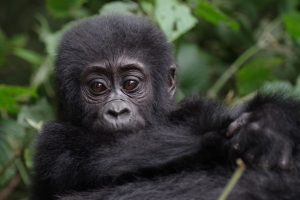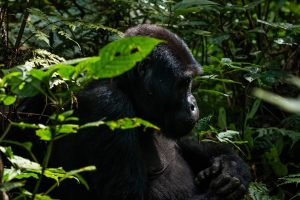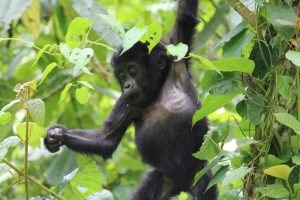Gorilla trekking is an experience that involves tracking habituated gorillas in the mountain forests of Uganda, Rwanda, and the Democratic Republic of Congo. It is one of the most popular breathtaking adventures done on an African safari. Mountain gorillas cannot survive outside their natural habitat, they only live in rainforests in only these 3 countries. During gorilla trekking you will spend hours in the dense tropical rainforests and mountains home to the remaining gorillas in the wild with experienced rangers and porters from Uganda wildlife authority for Uganda, Rwanda Development Board for Rwanda and lastly, IUNC of Congo will accompany you throughout the trek, they will be cutting through the thick jungle, pointing out signs of gorillas and help locate the gorillas.
Mountain gorillas can be found in Uganda’s Bwindi Impenetrable Forest National Park which is home to half of the world’s population of mountain gorillas. It has 21 habituated gorilla families to trek and Mgahinga Gorilla National Park has one habituated gorilla family to trek. These are the only two places in Uganda to see mountain gorillas.
The gorillas can also be seen in Volcanoes National Park in Rwanda and Virunga National Park in Congo. Just like most wildlife gorillas are territorial and protective of their families. They are gentle creatures, as long as they don’t view you as a threat. However, if you come across an unhabituated gorilla, it can be dangerous. This is why only habituated gorillas are tracked.



In Uganda, a gorilla trekking permit costs $ 800 per person for foreign nonresidents, $700 for foreign residents, the rest of Africans $500 and Ugx.3000,000 per person for East African citizens. There are 22 habituated families to trek in Uganda and each family has 8 permits daily, making 176 permits available per day.
In Rwanda, a gorilla trekking permit costs $1,500, making it a luxury gorilla trekking destination. A gorilla trekking permit in Congo costs $400 for foreigners and $200 for nationals.
Gorilla permits in Uganda can be purchased at Uganda Wildlife Authority (UWA). 75% of the fees are for conservation and this provides means of protection for the national parks and their inhabitants. This cost or fee is for the permits only it doesn’t include transport, accommodation, park fees, and other costs incurred.
Gorilla permits in Rwanda are issued by Rwanda Development Board in Kigali and trekking permits in Congo are obtained from The Institut Congolese pour la Conservation de la Nature (ICCN).
One can acquire a permit through a tour operator who can keep track of the permit. Since booking in advance is essential to avoid disappointment because these permits are very competitive.
January to February is the best time to see mountain gorillas in Uganda. It is one of the dry seasons which makes tracking and viewing wildlife easier. There are also fewer trekkers so less competition for gorilla permits. There are two seasons for trekking which are high season (June to September and December to February) and low season (March to May and October to November).
Gorilla tours are available even during the rainy seasons. Additionally, lodges and permit rates are usually reduced during the wet season because trekkers are few compared to dry seasons.
February to March is the best time to track gorillas in Rwanda. It is close enough to the wet season that Volcanoes National Park will not be too busy. It is also still the dry season, and this makes trekking easier. The trekking periods in Rwanda are split into high seasons (May to October and December to March) and low seasons (March to May and October to November).
The best time to go for gorilla trekking in Congo is during the dry seasons of June to September and December to February however Virunga National Park particularly, has a very wet climate. It can rain at any time but during that time there is less rain, and the forest trails tend to be less slippery.
March to April and October to November have heavy and long rains. You’ll get good deals on lodges over this time and gorilla trekking fees might be reduced too.
You will need to wear the correct clothing to trek through the thick tropical rainforests. Here are some of the things to wear for the trek, such as waterproof hiking boots, a poncho/ rain jacket, Long trousers, Long sleeve shirt, gloves.
The other gear to carry along is; binoculars, an extra sweater, insect repellent, lunch, snacks, a bottle of drinking water, a camera and batteries, a walking stick (which can be provided at the briefing area), and lastly a basic first aid kit.
The landscapes of the main gorilla trekking parks in Uganda and Rwanda are very different. One needs a good fitness level to track gorillas. It also depends on the season you trek in because you will be tracking gorillas through a mountainous rainforest. Certain routes are steeper than others. Even the easiest route will need a moderate level of fitness and experience.
Gorilla tracking is easier in the dry seasons compared to rainy seasons when the slopes are slippery and muddy. Vegetation is denser in the wet season, as well. You will need more energy than when the terrain is dry.
Volcanoes National park is part of a mostly dormant volcanic mountain range known as the Virungas. Here, the gorillas stay almost exclusively in the bamboo forest zone with a beautiful setting in which one can see these great apes. The vegetation tends to be quite open, which is ideal for easy viewing.
In Uganda at Bwindi Impenetrable Forest Gorilla trekking begins at 7:30 am with a 30-minute briefing. You are placed in groups of 8 and then the staff explains the trekking rules. At 8 am your guides will lead you through the dense forest. Pay close attention as you can be able to spot other wildlife species, birds, and unique vegetation as you trek. The dry months are the best time to spot animals. Always have a lookout and listen to the guides and follow the rules given as they are safety measures.
Gorilla trekking usually takes between 2-6 hours. This depends on which gorilla family you are tracking. The mountain gorillas move around a lot for food just like other primates. You may end up climbing steep slopes before you encounter them. You need to be physically fit before engaging in this adventure.
When you reach the gorillas, the guides will remind you to keep a 10-meter distance and to keep your voice low. The flash on your camera must be off before you take pictures. You will finally spend up to an hour with the great apes, and your guides will answer any questions you may have. After that, you will head back to the park headquarters where you will awarded a certificate of completion
The minimum age requirement for Bwindi Impenetrable National Park in Uganda, Volcanoes National Park in Rwanda and Virunga National Park in Congo is 15 years old.
Fairend Safaris
We specialize in customized safari expeditions right into the heart of Africa. Let’s take you on a journey of a lifetime.
Contact us, send us an email and our customer support team will is here to answer all your questions.